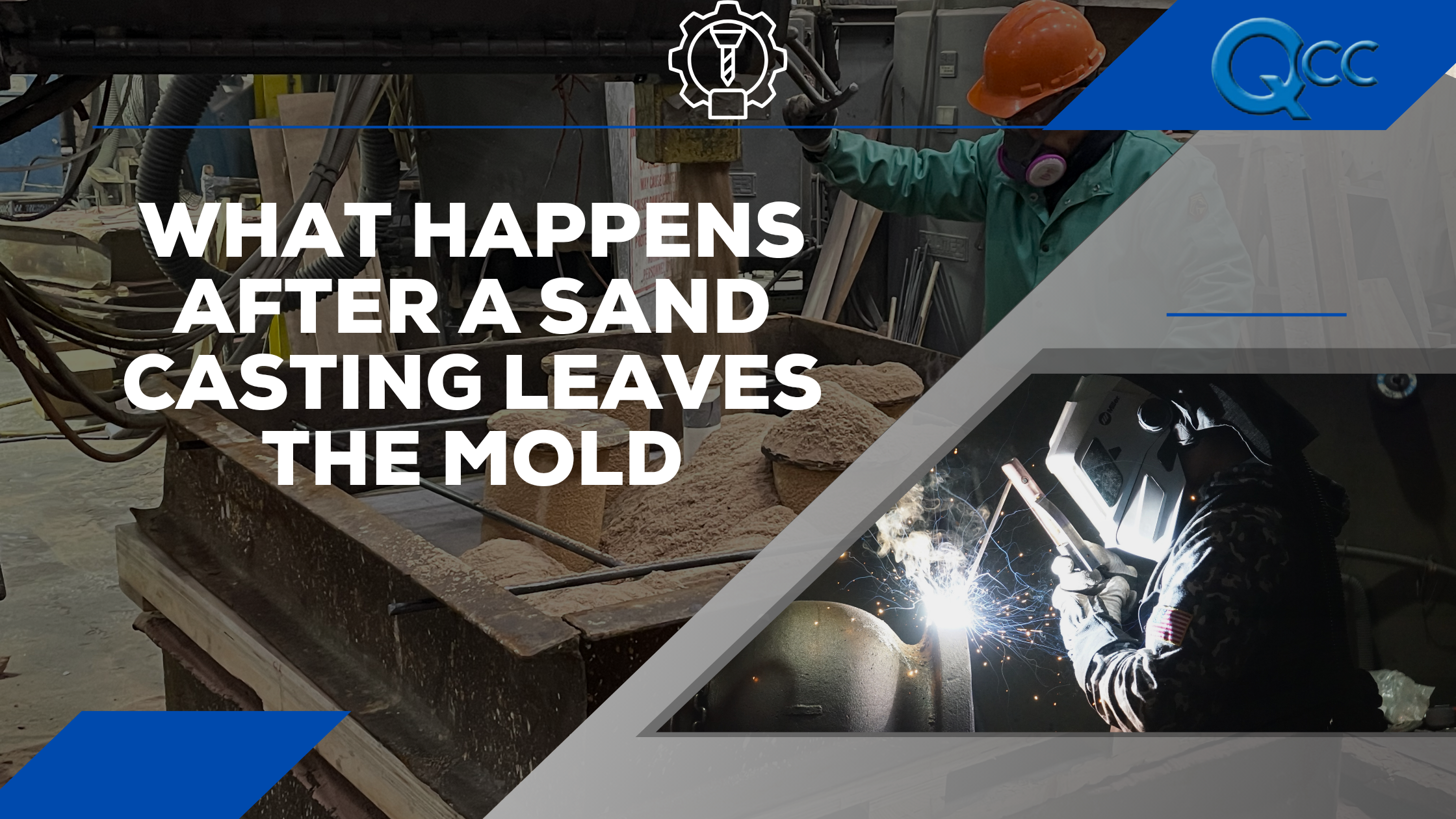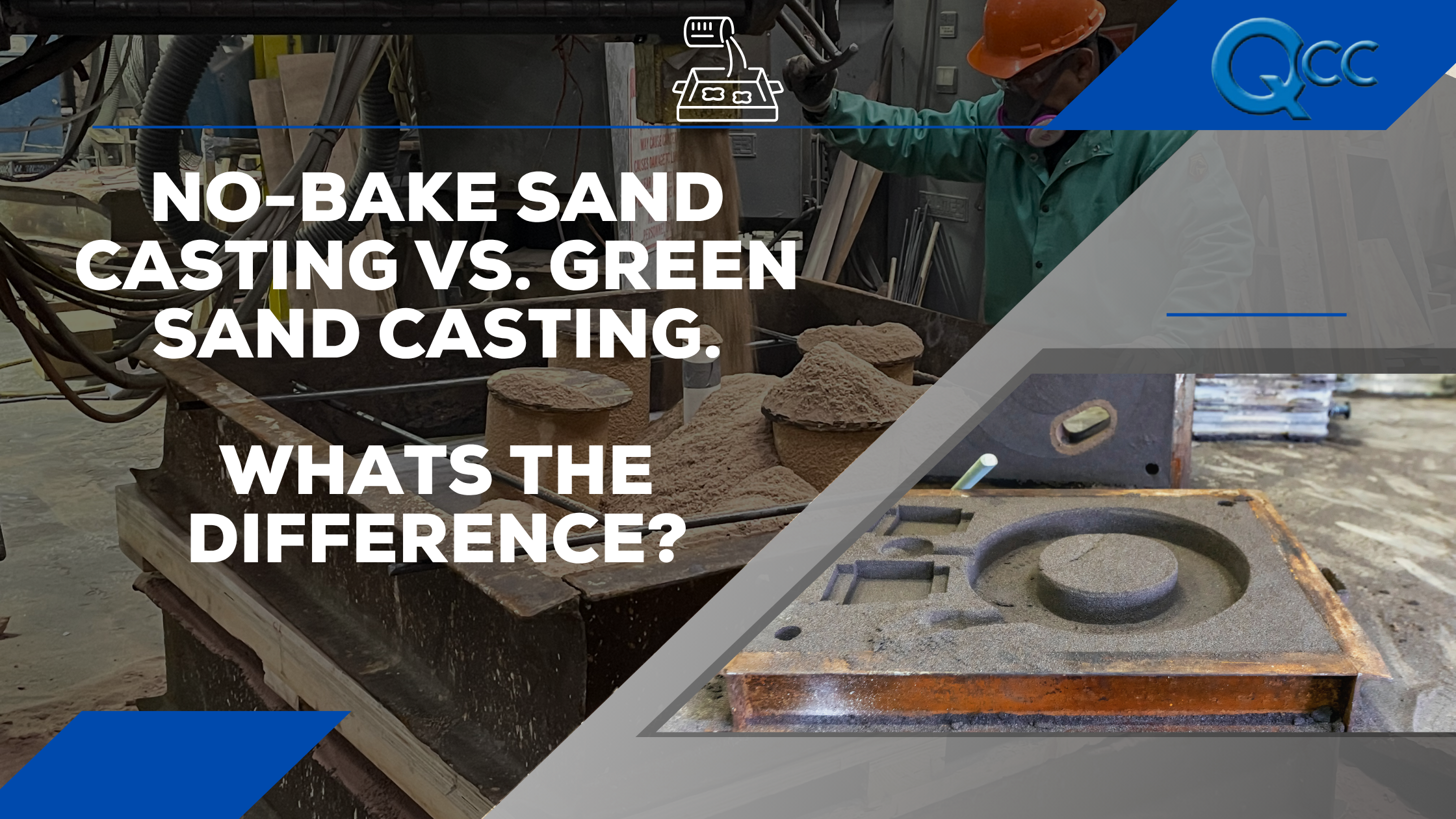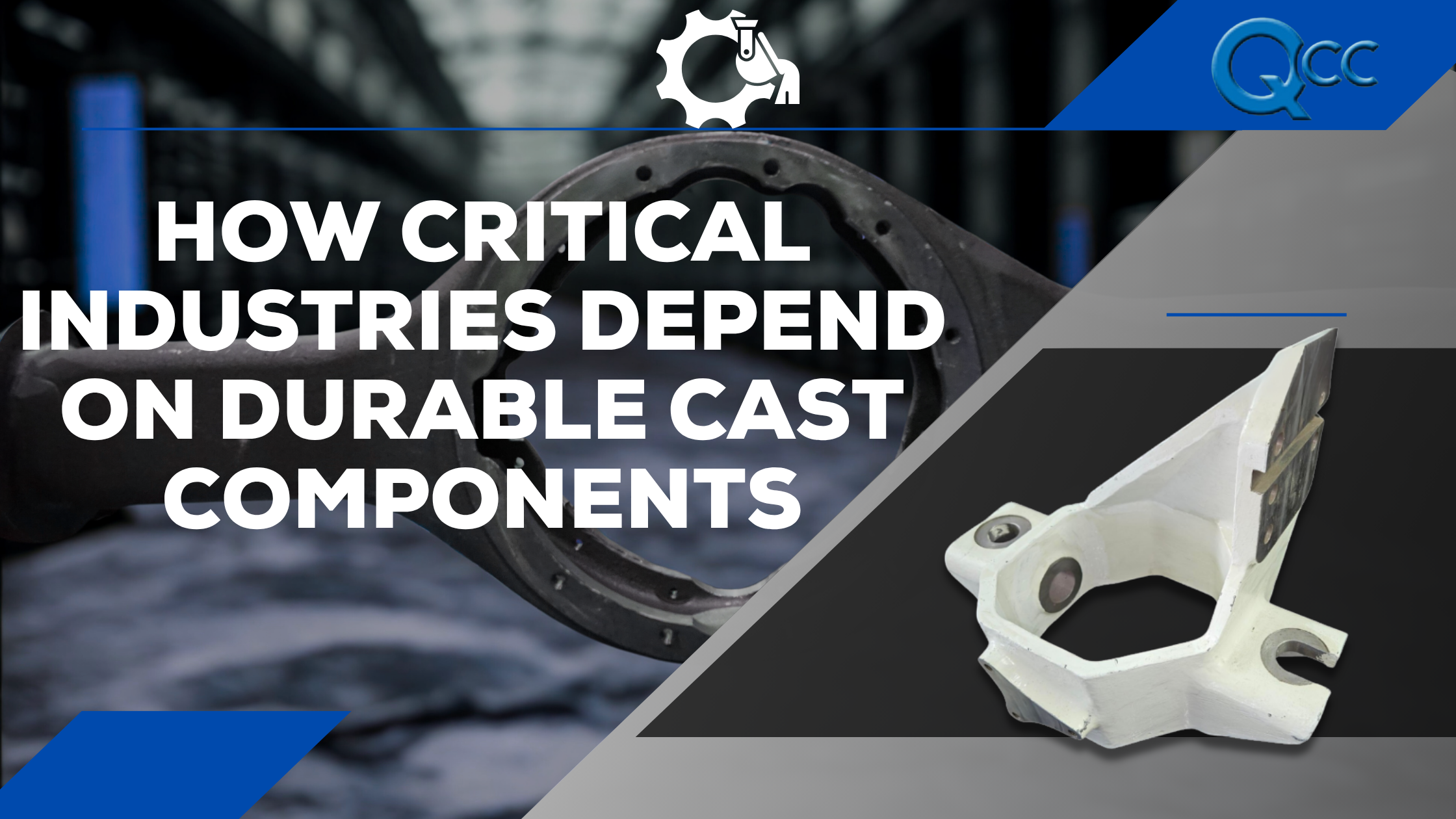The Power of Steel: Inside a Modern Steel Foundry
Step inside a modern steel foundry, where raw materials are transformed into the strong, durable steel that supports the infrastructure of our everyday lives. From the roar of furnaces to the precision of alloying, the steel foundry is where tradition meets innovation—fueling industries from construction and automotive to aerospace and defense.
At Quaker City Castings, we take pride in being a trusted name in steel casting. As a leading steel foundry, we combine expert craftsmanship with advanced manufacturing technologies to produce high-quality steel components that meet the most demanding standards.
In this blog, we’ll walk you through the entire steel foundry process, from sourcing iron ore and scrap metal to melting, refining, pouring, and finishing. You’ll learn how steel is made, why quality matters, and how foundries like ours shape the future of manufacturing.
Join us on this journey into the heart of steel production and discover the incredible science, engineering, and skill behind one of the world’s most important materials.
.
What is a Steel Foundry?

Have you ever stopped to think about where the steel in your car, the structural beams of skyscrapers, or even the frame of your refrigerator comes from? The answer lies in a steel foundry—a place like Quaker City Castings, where raw materials are forged into the essential components of modern life.
A steel foundry is more than just a factory—it’s a high-temperature workshop of precision and power, where skilled metallurgists and advanced machinery come together to mold molten steel into mission-critical parts. Whether it’s heavy-duty gears, industrial valves, or structural castings, each piece begins with a careful combination of art and science.
This is where innovation meets tradition. Intense heat, exacting specifications, and decades of foundry expertise converge to create the strong, resilient materials that fuel our industries, support our cities, and drive the technologies of tomorrow. At Quaker City Castings, we don’t just pour steel, we shape the future.
History and Evolution of Steel Production

Steel has shaped human progress for thousands of years. Early civilizations, from the Hittites to the Chinese, worked with rudimentary forms of iron and steel to craft tools, weapons, and infrastructure. But it wasn’t until the Industrial Revolution that the steel foundry as we know it truly emerged.
A pivotal moment came in the mid-19th century with the invention of the Bessemer process by Sir Henry Bessemer. This breakthrough method involved blowing air through molten iron to remove impurities, creating stronger, more malleable steel. For the first time in history, steel could be mass-produced efficiently and affordably—fueling the rise of railroads, bridges, and modern buildings. It was the spark that ignited a new era of industrialization.
The Bessemer process laid the groundwork for the development of modern steel foundries, which continued to evolve with advancements in metallurgy and engineering. By the 20th century, new technologies like the basic oxygen furnace (BOF) and the electric arc furnace (EAF) had further transformed steelmaking. BOF systems refine molten iron using pure oxygen, while EAFs recycle scrap metal using high-voltage electric arcs—both processes offering precision, scalability, and environmental efficiency.
Today’s steel foundries, including Quaker City Castings, operate at the intersection of tradition and innovation. While the core concept of melting and casting steel remains the same, the techniques have become safer, cleaner, and more technologically advanced. From handcrafted molds to automated pouring systems, the modern steel foundry continues to evolve, building on centuries of knowledge to meet the demands of the 21st century and beyond.
The Steelmaking Process Inside a Modern Steel Foundry
The steelmaking process in a modern steel foundry is a carefully controlled sequence of steps that transforms raw materials into high-performance steel components. From mining iron ore to final casting, each phase requires precision, expertise, and state-of-the-art technology.
It all begins with the sourcing of raw materials, primarily iron ore, along with coke (a carbon-rich material derived from coal) and limestone. Iron ore is typically extracted through surface or underground mining. Once mined, the ore is crushed, concentrated, and processed to remove impurities—preparing it for the journey from rock to refined metal.
In traditional steelmaking, the next step is the blast furnace, where iron ore, coke, and limestone are layered and heated to extreme temperatures. This process melts the iron and produces molten pig iron, which is then tapped from the furnace. However, in many modern steel foundries, including Quaker City Castings, steel is made or refined using one of two primary methods: the Basic Oxygen Furnace (BOF) or the Electric Arc Furnace (EAF).
-
The BOF method involves injecting pure oxygen into molten pig iron, rapidly oxidizing impurities and converting it into high-quality steel.
-
The EAF method is more flexible and sustainable, as it uses electricity to melt recycled scrap steel. EAFs are especially valued for their efficiency and lower environmental impact.
Once refined, the molten steel is ready to be made into a steel casting. This stage is where the steel foundry truly showcases its expertise. The molten metal is poured into custom-designed molds—either sand molds, permanent molds, or investment molds—depending on the desired shape and application. After cooling and solidification, the castings are removed, cleaned, and further processed through machining, heat treatment, or finishing to meet exacting customer specifications.
The result is a high-strength, precisely engineered product ready for use in industries like energy, transportation, defense, and heavy machinery.
Key Components and Equipment Used in a Steel Foundry

Producing high-quality steel in a steel foundry demands a wide range of specialized equipment, each playing a vital role in transforming raw materials into reliable, high-performance products. From smelting to shaping, every stage of steel production is powered by tools and technologies designed for precision, efficiency, and durability.
At the heart of traditional steelmaking is the blast furnace—a towering structure capable of withstanding extreme heat and pressure. Made of durable refractory materials, the blast furnace is responsible for smelting iron ore with coke and limestone at temperatures exceeding 2,000°F, producing molten iron as the first critical step in the journey toward finished steel.
In the Basic Oxygen Furnace (BOF) method, the process continues in a large vessel known as a converter. Here, molten iron from the blast furnace is mixed with steel scrap, and pure oxygen is injected into the mix. This intense chemical reaction removes excess carbon and impurities, producing clean, high-quality steel.
Meanwhile, in the Electric Arc Furnace (EAF) method—common in many modern steel foundries—scrap steel is melted directly using high-voltage electric arcs. The EAF process is particularly valued for its energy efficiency and ability to recycle existing materials, making it a cornerstone of sustainable steelmaking.
Beyond furnaces, a wide array of auxiliary equipment is used throughout the steel foundry workflow:
-
Ladles transport and pour molten metal between stations.
-
Tundishes regulate the flow of steel into molds during continuous casting.
-
Rolling mills shape steel into bars, sheets, or other forms.
-
Cutting and finishing machines trim, treat, and prepare the final product for delivery.
Each piece of equipment serves a specific and essential function, contributing to the streamlined, high-precision environment of a modern steel foundry. At Quaker City Castings, our investment in advanced machinery ensures consistent quality, greater efficiency, and the ability to meet the exacting standards of industries worldwide.
Advantages and Applications of Steel in Various Industries

Steel’s remarkable combination of strength, durability, and versatility makes it one of the most indispensable materials in modern industry. Produced in steel foundries like Quaker City Castings, it serves as the foundation for progress across countless sectors—from towering skyscrapers to everyday household appliances.
In the construction world, steel plays a pivotal role in shaping the structural backbone of our cities. Its high strength-to-weight ratio allows architects and engineers to design buildings, bridges, and stadiums that are not only massive and load-bearing but also safe and efficient. Steel’s resilience under stress, including its performance in seismic zones, makes it an ideal choice for building infrastructure that lasts.
The automotive industry also relies heavily on steel for both safety and performance. Modern vehicles incorporate advanced high-strength steels that enhance crash resistance and energy absorption, helping protect passengers in the event of an accident. As the demand for fuel-efficient vehicles grows, manufacturers turn to steel to reduce weight without compromising structural integrity.
In aerospace, steel’s reliability is tested in the most extreme conditions. Its ability to withstand high temperatures, pressure, and fatigue makes it essential for aircraft engines, landing gear, and other critical components. Whether for commercial jets or military aircraft, steel’s unmatched performance under stress makes it a trusted material in aviation.
Even outside of heavy industry, steel remains a staple in everyday life. Foundry-produced steel is used in appliances, tools, furniture, and kitchenware, valued for its strength, formability, and resistance to corrosion. From the frame of a refrigerator to the blade of a kitchen knife, steel delivers long-lasting function and modern aesthetics.
Across all of these applications, the common thread is clear: steel foundries provide the essential material that powers innovation, safety, and durability across the industries we rely on every day.
Innovations and Advancements in Modern Steel Foundries
Modern steel foundries are no longer just places where molten metal is poured into molds—they are hubs of advanced engineering, digital integration, and high-precision manufacturing. As technology continues to evolve, so does the steelmaking process, leading to unprecedented levels of efficiency, quality, and customization.
One of the most transformative developments in modern foundries is the adoption of computer-aided design (CAD) and computer-aided manufacturing (CAM). These tools enable engineers to design highly complex geometries and simulate casting outcomes before production even begins. By minimizing material waste and identifying potential flaws early in the process, CAD/CAM systems help steel foundries reduce costs and improve final product performance.
Automation has become a cornerstone of modern steel production. Industrial robots and automated machinery now handle many of the repetitive, labor-intensive, and hazardous tasks involved in the foundry environment—such as mold handling, pouring, and cleaning. This not only improves productivity but also enhances worker safety and reduces variability in production.
In today’s steel foundry, the process of alloying, adding elements such as chromium, nickel, or molybdenum, is done with greater control and precision. These advanced alloying techniques allow for the creation of steel grades tailored to specific applications, whether that’s corrosion resistance for marine use or extreme strength for aerospace components.
At Quaker City Castings, we’re also pioneering the use of 3D-printed sand molds in our steel casting process. These molds can be produced quickly and with tighter dimensional tolerances than traditional methods, allowing for more intricate designs and shorter lead times. This innovation opens the door for more flexible production and rapid prototyping for clients.
The integration of data analytics and machine learning is transforming steelmaking into a more intelligent, predictive process. Modern foundries are using real-time data to monitor furnace temperatures, casting speeds, and cooling rates—then feeding this information into algorithms that can identify inefficiencies, forecast maintenance needs, and ensure consistent quality.
Innovation is the heartbeat of a modern steel foundry. At Quaker City Castings, we’re committed to investing in new technologies and refining our processes so we can continue delivering the high-performance steel products our customers rely on. As the industry moves forward, we’re proud to be at the forefront of this new era in steel production.
Challenges and Solutions in the Steelmaking Process
Although today’s steel foundries have embraced major technological advancements, they still face a range of challenges in the ongoing pursuit of efficiency, quality, and sustainability. These hurdles span from the volatility of raw material supply chains to increasing environmental regulations and unpredictable market conditions.
One persistent challenge is the availability and cost of raw materials. Iron ore—the primary ingredient in steel production—is a non-renewable resource, and global demand continues to rise. Securing consistent access to high-grade iron ore is critical for maintaining production levels and quality. As a result, many foundries are actively exploring alternative sources, investing in more efficient extraction methods, and improving material utilization to minimize waste.
Energy consumption is another significant concern. Steel production remains one of the most energy-intensive industrial processes, requiring substantial electricity and fuel inputs. With rising energy costs and increasing pressure to reduce carbon emissions, steel foundries must continually search for innovative solutions. Many are now implementing energy-efficient technologies, heat recovery systems, and even integrating renewable energy sources to reduce their environmental footprint and operating expenses.
Economic fluctuations also impact the industry. Steel is a globally traded commodity, and its pricing is heavily influenced by shifts in supply, demand, and geopolitical factors. These market dynamics can affect profitability, long-term planning, and overall competitiveness. To stay resilient, modern foundries must be agile—diversifying their product offerings, investing in lean manufacturing, and strengthening relationships with both suppliers and customers.
Despite these ongoing challenges, the steel industry remains a cornerstone of modern civilization. Through continued innovation, sustainability efforts, and strategic adaptation, steel foundries like Quaker City Castings are working to overcome these obstacles and forge a stronger, more sustainable future for the industry and the world it supports.
The Future of Steel Production and Its Impact on Society

The future of steel production is bright, fueled by technological progress and a growing global focus on sustainability. As demand continues to climb—particularly in developing regions—modern steel foundries will play an essential role in meeting the world’s needs with innovation, precision, and efficiency.
A key area of advancement lies in the development of next-generation steel alloys. Engineers and researchers are working to enhance the material’s performance through advanced alloying techniques, making steel even stronger, more corrosion-resistant, and better suited for specialized applications. These innovations are unlocking new possibilities in sectors like construction, automotive, aerospace, and beyond.
Global trends are also shaping the future of steel. Rapid urbanization and industrialization in emerging economies are driving an unprecedented need for high-quality steel. Foundries are adapting to this shift by scaling production, embracing sustainable practices, and optimizing supply chains to ensure steel remains a reliable foundation for global infrastructure and economic development.
Throughout history, steel has been a driving force behind human progress. From ancient blacksmithing to modern metallurgy, this material has shaped societies and built civilizations. Today’s steel foundries carry that legacy forward, combining deep industry knowledge with cutting-edge technology to push the limits of what steel can achieve.
The journey from raw iron ore to finished steel products is both intricate and impressive. Every step—from mining and refining to casting and finishing—requires skill, expertise, and a commitment to quality. Steel foundries are more than manufacturing facilities; they are hubs of innovation, responsible for producing the material that makes modern life possible.
As industries and consumers continue to depend on steel for its unmatched strength and versatility, the role of steel foundries becomes increasingly vital. These facilities are the guardians of steel’s legacy, refining and evolving the material that builds our cities, powers our transportation, and supports the technology of tomorrow.
So whether you’re walking through a towering steel-framed building, driving a car, or flying across the globe, take a moment to recognize the extraordinary processes—and the people behind them—that bring steel to life.
Quaker City Castings is a premier steel foundry and leader in your steel casting needs. Click here to learn more about how Quaker City Castings can help you on your next project.





Leave A Comment